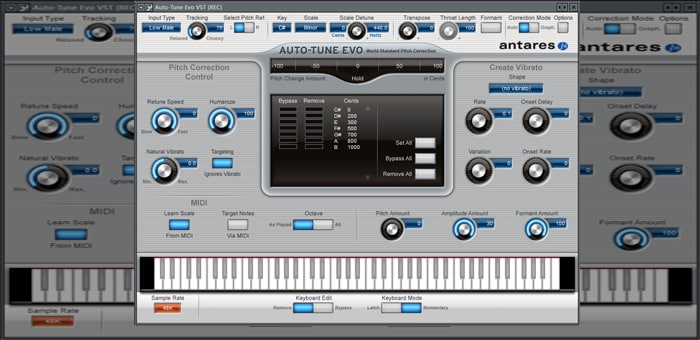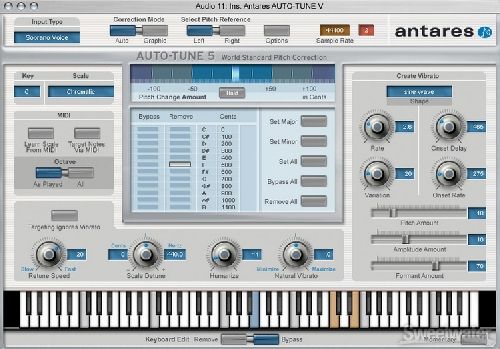A UA exclusive, the Antares Auto-Tune Realtime Advanced plug-in improves the previous UAD version with powerful workflow and sonic enhancements, making it the ultimate ultra-low-latency tuning solution for Apollo and Arrow interfaces — optimized for insta. Mar 10, 2020 Here is EVERY version of Auto-Tune explained: 1. Auto-Tune Access ($99) - LIMITED.simple - that's all. Simple - that's all 2. Auto-Tune EFX+ ($199) - GOOD.the effects are a nice bonus.
What I find most fascinating about Antares Auto-Tune is that everyone and their mother knows what it is, despite the fact that it's just another digital audio plugin used in bedroom and professional studios alike. Even people who have no clue what an EQ or compressor does somehow at least know of the word 'Auto-Tune' and even the general effect it has on the human voice.
But even though Auto-Tune has evolved to become this cultural phenomenon, very few artists or producers truly understand how to get it to sound like the way it sounds on major records.
In case you don't know what it is, Auto-Tune, in a nutshell, is a pitch correction software that allows the user to set the key signature of the song so that the pitch of the incoming signal will be corrected to the closest note in that key (and does so in real time). There are other pitch correction programs out there that do similar functions: Waves Tune, Waves Tune Real-Time, and Melodyne (which is pitch correction, but not in real time), but Auto-Tune seems to have won the standard for real-time pitch correction.
Auto-Tune traditionally is used on vocals, although in some cases can be used on certain instruments. For the sake of this article we will be discussing Auto-Tune and its effect on the human voice. Listen to this early example from the 'King of Auto-Tune,' the one artist who did more to popularize its effect than any other, T-Pain.
Working as a full-time engineer here at Studio 11 in Chicago, we deal with Auto-Tune on a daily basis. Whether it's people requesting that we put it on their voice, something we do naturally to correct pitch, or even for a specific creative effect. It's just a part of our arsenal that we use everyday, so over the years we have really gotten to know the ins and outs of the program—from its benefits to limitations.
So let's delve further into what this software really is and can do, and in the process debunk certain myths around what the public or people who are new to Auto-Tune may think. If you were ever wondering why your Auto-Tune at home doesn't sound like the Auto-Tune you hear from your favorite artists, this is the article for you.
To set the record straight, as I do get asked this a lot of times from clients and inquiring home producers, there really are no different 'types' of Auto-Tune. Antares makes many different versions of Auto-Tune—Auto-Tune EFX, Auto-Tune Live, and Auto-Tune Pro—that have various options and different interfaces, but any of those can give you the effect you're after. Auto-Tune Pro does have a lot of cool features and updates, but you don't need 'Pro' to sound pro.
I wanted to debunk this first, as some people come to me asking about the 'the Lil Durk Auto-Tune,' or perhaps that classic 'T-Pain Auto-Tune.' That effect is made from the same plugin—the outcome of the sound that you hear depends on how you set the settings within the program and the pitch of the incoming signal.
So if your Auto-Tune at home sounds different from what you hear on the radio, it's because of these factors, not because they have a magic version of Auto-Tune that works better than yours at home. You can achieve the exact same results.
In modern music Auto-Tune is really used with two different intentions. The first is to use it as a tool in a transparent manner, to correct someone's pitch. In this situation, the artist doesn't want to hear the effect work, they just want to hit the right notes. The second intent is to use it as an audible effect for the robotic vocals you can now hear all over the pop and rap charts.
Plugin That's A Better Version Of Auto Tune Lyrics
But regardless of the intent, in order for Auto-Tune to sound its best, there are three main things that need to be set correctly.
The correct key of the song. This is the most important part of the process and honestly where most people fail. Bedroom producers, and even some engineers at professional studios who might lack certain music theory fundamentals, have all fallen into the trap of setting Auto-Tune in the wrong key. If a song is in C major, it will not work in D major, E major, etc.—though it will work in C major's relative minor, A minor. No other key will work correctly. It helps to educate yourself a bit about music theory, and how to find the key of a song.
The input type. You have the option to choose from Bass Instrument, Instrument, Low Male, Alto/Tenor, and Soprano. Bass Instrument and Instrument are, of course, for instruments, so ignore them if you're going for a vocal effect. Low Male would be selected if the singer is singing in a very low octave (think Barry White). Alto/Tenor will be for the most common vocal ranges, and soprano is for very high-pitched vocalists. Setting the input type correctly helps Auto-Tune narrow down which octaves it will focus on—and you'll get a more accurate result.
Retune speed. This knob, while important, is really all dependent on the pitch of the input source, which I will discuss next. Generally speaking, the higher the knob, the faster it will tune each note. A lower speed will have the effect be a bit more relaxed, letting some natural vibrato through without affecting a vocalist's pitch as quickly. Some view it as a 'amount of Auto-Tune knob,' which isn't technically true. The amount of correction you hear is based off the original pitch, but you will hear more effects of the Auto-Tune the faster it's set.
So let's say you have all of these set correctly. You have the right key, you choose the right range for the singer, and the retune speed is at its medium default of 20ms. You apply it on the singer expecting it to come out just like the pros. And while their voice does seem to be somewhat corrected, it's still not quite corrected to the right pitch.

Here's why your Auto-Tune doesn't sound like the pros:
The pitch of the vocalist prior to Auto-Tune processing must be close enough to a note in the scale of the key of the song for Auto-Tune to work its best. In other words, the singer has to be at least near the right note for it to sound pleasing to the ears.
Whether you're going for a natural correction or the T-Pain warble, this point still stands. If the note the singer originally sings is nowhere near the correct note in the key, Auto-Tune will try to calculate as best it can and round up or down, depending on what note is closest. And that's when you get undesirable artifacts and hear notes you weren't expecting to hear. (Here is an example of how it sounds when the incoming pitch isn't close enough to the scale, resulting in an oddly corrected pitch.)
So if you put Auto-Tune on a voice and some areas sound good, some sound too robotic and a bit off, those are the areas that the singer needs to work on. Sometimes it can be difficult for non-singers to hear slight sharp or flat notes, or notes that aren't in the scale of the song, so Auto-Tune in many cases can actually help point out the problem areas.
This is why major artists who use Auto-Tune sound really good, because chances are they can sing pretty well before Auto-Tune is even applied. The Weeknd is a great example of this—he is obviously a very talented singer that has no problem hitting notes—and yet his go-to mixer, Illangelo, has said before that he always uses at least a little bit of Auto-Tune on the vocals.

If you or the singer in your studio is no Weeknd, you can correct the pitch manually beforehand with a program like Melodyne, or even with built-in pitch correction tools in your DAW, where you can actually go in and change the pitch of each syllable manually. So if you find yourself in a situation where you or an artist you are working with really want Auto-Tune on their vocals, but it's not sounding right after following all the steps, look into correcting the pitch before you run it through Auto-Tune.
Plugin That's A Better Version Of Auto Tune 2
If you get the notes closer to the scale, you'll find the tuning of Auto-Tune to be much more pleasing to the ears. For good reason, T-Pain is brought up a lot when discussing Auto-Tune. Do you want to know why he sounds so good? It's not a special Auto-Tune they are using, its because he can really sing without it. Check it out:
Plugin That's A Better Version Of Auto Tune Free
Hopefully this helps further assist you in your understanding and use of Antares Auto-Tune, and debunk some of the myths around it. Spend some time learning some basic music theory to help train the ear to identity keys of songs, find which notes are flat and which notes are sharp. Once you do, you'll find you'll want to use Auto-Tune on every song, because let's face it—nearly a decade after Jay-Z declared the death of Auto-Tune on 'D.O.A.'—it still sounds cool.
Plugin That's A Better Version Of Auto Tune Lyrics
We understand the importance of online privacy and are committed to complying with the EU General Data Protection Regulation. To reflect our commitment, we updated our terms and conditions. By continuing to use Reverb, you agree to these updates, and to our cookie policy. Learn More